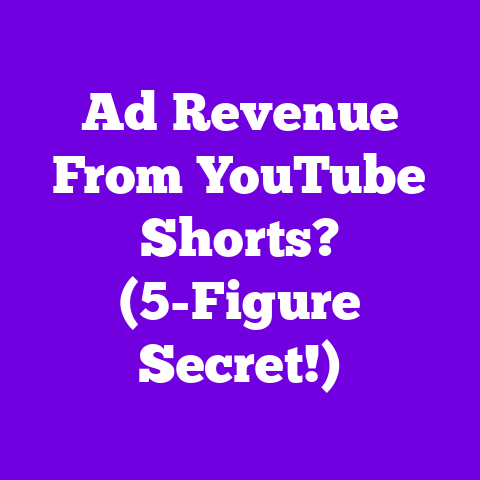Affiliate Links for YouTube (1 Hour Till Gone?)
Imagine this: you’re a YouTube creator, finally hitting your stride.
Views are up, engagement is soaring, and you’re building a real community.
But there’s that nagging feeling: how do you turn this passion into profit?
That’s where affiliate links come in.
They offer a sense of comfort, knowing you can monetize your hard work, fueling your creative journey.
But in the fast-paced digital world, things change quickly.
What works today might be obsolete tomorrow.
That’s why the phrase “1 Hour Till Gone?” resonates so deeply.
It’s a reminder of the urgency we face in the digital marketplace.
This article dives deep into the evolving landscape of affiliate marketing on YouTube.
We’ll explore its history, mechanics, and future, focusing on 2025.
Consider this your roadmap to navigating this crucial monetization tool.
We will cover:
-
The Evolution of Affiliate Marketing on YouTube.
-
Understanding the Mechanics of Affiliate Links.
-
The Impact of Trends and Technology on Affiliate Links.
-
Strategies for Maximizing Affiliate Link Revenue.
-
The Future of Affiliate Links on YouTube.
Let’s get started!
Section 1: The Evolution of Affiliate
Marketing on YouTube
Affiliate marketing, in its simplest form, is a partnership.
You, as a creator, recommend a product, and when someone buys it through your unique link, you earn a commission.
The concept isn’t new.
It’s been around since the early days of e-commerce, with Amazon launching its affiliate program in 1996.
But its application on YouTube has transformed dramatically.
Initially, it was a niche strategy.
A few tech reviewers or beauty gurus would casually drop affiliate links.
Now, it’s a mainstream monetization method, embraced by creators across all niches.
Think about it: from gaming channels linking to gaming peripherals to fitness vloggers promoting workout gear, affiliate marketing is everywhere.
Several key milestones in YouTube’s history have shaped this evolution.
One major turning point was the introduction of the YouTube Partner Program (YPP).
This program allowed creators to monetize their content through ads, but it also opened doors for affiliate marketing.
As the algorithm evolved, rewarding channels that provided value and engaged their audience, affiliate marketing became even more appealing.
Creators realized that by recommending products they genuinely believed in, they could not only earn revenue but also build trust with their viewers.
Policy changes have also played a role.
YouTube’s community guidelines regarding transparency and disclosure have pushed creators to be upfront about their affiliate relationships.
This has fostered a more ethical and sustainable approach to affiliate marketing, benefiting both creators and consumers.
The growth of affiliate marketing revenue for YouTube creators has been impressive.
While precise figures are difficult to pinpoint due to the diverse range of affiliate programs and individual creator strategies, industry reports offer valuable insights.
For example, a report by Statista estimates that the affiliate marketing industry as a whole will reach \$8.2 billion in spending by 2022.
While this number isn’t specific to YouTube, it reflects the overall growth of the industry, and YouTube creators are undoubtedly contributing significantly to this expansion.
I’ve seen firsthand how affiliate marketing can transform a channel.
I recall working with a small DIY channel that started incorporating affiliate links to tools and materials they used in their projects.
Within a few months, their affiliate revenue surpassed their ad revenue, allowing them to invest in better equipment and create more high-quality content.
This is just one example, but it illustrates the potential of affiliate marketing when done strategically and authentically.
Section 2: Understanding the Mechanics
of Affiliate Links
So, what exactly is an affiliate link, and how does it work within the YouTube ecosystem?
Simply put, an affiliate link is a unique URL provided by an affiliate program that tracks the traffic and sales generated from your channel.
When a viewer clicks on your affiliate link and makes a purchase, the affiliate program records the transaction and credits you with a commission.
The commission rate varies depending on the affiliate program and the product being promoted.
It can range from a few percentage points to upwards of 50% or more.
Setting up affiliate links involves a few key steps:
Choosing Affiliate Programs: Research and select affiliate programs that align with your niche and audience.
Popular options include Amazon Associates, ShareASale, and Commission Junction, but there are also many niche-specific programs available.-
Generating Links: Once you’re approved for an affiliate program, you can generate unique affiliate links for specific products or services.
Integrating Links into Content: The key is to seamlessly integrate these links into your videos and descriptions.
You can mention the product in your video and provide the link in the description box.Tracking and Optimizing: Use the analytics tools provided by the affiliate program to track the performance of your links.
Identify which products are generating the most revenue and adjust your strategy accordingly.
Transparency is paramount when using affiliate links.
YouTube’s community guidelines and legal requirements mandate that you disclose your affiliate relationships to your viewers.
This can be done by adding a clear and concise disclaimer to your video description, such as “This video contains affiliate links, which means I may earn a small commission if you make a purchase through them.”
I always recommend being upfront and honest with your audience.
Don’t try to hide your affiliate links or deceive your viewers.
Building trust is essential for long-term success in affiliate marketing.
Section 3: The Impact of Trends and
Technology on Affiliate Links
The way people consume content is constantly evolving.
The rise of short-form videos, popularized by platforms like TikTok and YouTube Shorts, has had a significant impact on affiliate marketing.
Viewers have shorter attention spans and are less likely to watch long-form videos.
This means that creators need to be more concise and engaging in their product recommendations.
Live streaming is another trend that’s shaping the affiliate marketing landscape.
Platforms like YouTube Live and Twitch allow creators to interact with their audience in real-time, providing a unique opportunity to promote affiliate products.
Creators can demonstrate products live, answer questions, and provide personalized recommendations.
Technology is also playing a crucial role.
AI-powered tools are helping creators analyze data, identify trends, and optimize their affiliate marketing efforts.
Analytics tools provide valuable insights into click-through rates, conversion rates, and revenue generation.
This data can be used to refine your strategy and improve your results.
Emerging technologies like augmented reality (AR) and virtual reality (VR) have the potential to revolutionize affiliate marketing.
Imagine viewers being able to virtually try on clothes or test out furniture in their own homes before making a purchase.
This would create a more immersive and engaging shopping experience, driving higher conversion rates.
Section 4: Strategies for Maximizing
Affiliate Link Revenue
Now, let’s talk about actionable strategies you can use to maximize your affiliate link revenue.
First and foremost, it’s crucial to align affiliate products with your niche and audience interests.
Don’t just promote any product that offers a high commission rate.
Focus on products that you genuinely believe in and that will provide value to your viewers.
This will not only increase conversion rates but also build trust with your audience.
For example, if you run a cooking channel, promote kitchen gadgets, cookware, and ingredients that you use in your recipes.
If you run a gaming channel, promote gaming peripherals, software, and accessories that you use in your gameplay.
Urgency is a powerful marketing tool that can be applied to affiliate links.
Creating a sense of urgency can encourage viewers to take immediate action.
This can be done by offering limited-time discounts, highlighting limited-stock products, or creating a countdown timer.
Remember the “1 Hour Till Gone?” concept?
It’s all about creating a sense of scarcity and encouraging viewers to act fast.
I once worked with a fashion blogger who partnered with a clothing brand to offer a limited-time discount to her followers.
She created a video showcasing her favorite items from the collection and emphasized that the discount would only be available for 24 hours.
The results were incredible.
Her affiliate sales skyrocketed, and the clothing brand saw a significant increase in traffic and revenue.
Section 5: The Future of Affiliate Links
on YouTube
Looking ahead to 2025, what changes can we expect in YouTube’s policies regarding affiliate marketing?
It’s difficult to predict with certainty, but we can make some educated guesses based on current trends and creator feedback.
I anticipate that YouTube will continue to emphasize transparency and disclosure.
They may introduce stricter guidelines regarding how affiliate links are presented and disclosed.
This could include requiring creators to use specific language in their disclaimers or implementing a standardized affiliate disclosure system.
I also expect that YouTube will continue to crack down on deceptive or misleading affiliate marketing practices.
This could include penalizing channels that promote low-quality products or make false claims.
For new creators, these changes could make it more challenging to get started with affiliate marketing.
They’ll need to be extra careful to comply with YouTube’s policies and avoid making any mistakes that could jeopardize their channels.
Established creators, on the other hand, may need to adapt their strategies to comply with the new guidelines.
This could involve updating their disclaimers, revising their product recommendations, or changing the way they promote affiliate links.
Despite these challenges, I believe that the future of affiliate marketing on YouTube is bright.
The platform offers a unique opportunity for creators to connect with their audience, build trust, and monetize their content.
As technology continues to evolve, we can expect to see even more innovative and engaging ways to promote affiliate products.
Conclusion
Affiliate links are a powerful tool for YouTube creators, offering a path to financial stability and the comfort of monetizing their passion.
We’ve explored the evolution of affiliate marketing on YouTube, the mechanics of affiliate links, the impact of trends and technology, strategies for maximizing revenue, and the potential future of affiliate links on the platform.
The key takeaway is that the affiliate marketing landscape is constantly evolving.
To stay ahead of the curve, you need to be adaptable, transparent, and strategic.
Embrace new technologies, experiment with different strategies, and always prioritize building trust with your audience.
Remember, while comfort in content creation is key, staying ahead of trends is essential for sustainable success.
So, go out there and leverage affiliate links mindfully and strategically.
Your success story awaits!





